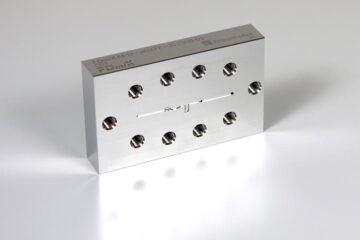UI researchers make first measurements of the solar wind termination shock

At the termination shock the solar wind, which continuously expands outward from the sun at over a million miles per hour, is abruptly slowed to a subsonic speed by the interstellar gas.
Don Gurnett, professor of physics in the College of Liberal Arts and Sciences and principal investigator for the plasma wave instrument on Voyager 2, and Bill Kurth, UI research scientist and Voyager co-investigator, said that the shock crossing was marked by an intense burst of plasma wave turbulence detected by the UI instrument, as well as by various effects detected by other instruments on the spacecraft.
At the time of the shock crossing, August 31, 2007, Voyager 2 was at a distance of 83.7 astronomical units (AU), roughly twice the distance between the Sun and Pluto. At this great distance, it took 11.2 hours for the radio signal from the spacecraft to reach Earth.
Shock waves in the thin, ionized gas — called plasma — that exists in space are similar in some respects to the shock waves produced by an airplane in supersonic flight. Shock waves in space are believed to play an important role in the acceleration of cosmic rays, which are very energetic atomic particles that continually bombard Earth. The most energetic cosmic rays, which are potentially hazardous to astronauts, are believed to be produced in intense shock waves caused by supernova explosions — immense stellar explosions that occur in massive stars toward the end of their lives.
The termination shock is believed to be responsible for the origin of less energetic cosmic rays called “anomalous cosmic rays.” The recent observations at the termination shock are expected to help physicists understand how cosmic rays are produced by the turbulent fields that exist in such shocks. Gurnett said, “There is no way for us to make direct measure of a super nova shock, so the Voyager 2 measurements at the termination shock provide us the best opportunity in the foreseeable future to understand how cosmic rays are produced by supernova cosmic shocks.”
Kurth noted that while some aspects of the termination shock matched scientists' expectations, a number of the observations made by Voyager were surprising and will cause a number of theories to be revised.
Gurnett noted that Voyager 2, launched in 1977, is moving at a speed of 38,000 miles an hour. Even at this considerable speed, the spacecraft will still take 30,000 years to reach a distance equal to that of the nearest star.
The sounds of Voyager's encounter with shock waves at various planets and other sounds of space can be heard by visiting the space audio Web site at: http://www-pw.physics.uiowa.edu/space-audio/.
Media Contact
All latest news from the category: Physics and Astronomy
This area deals with the fundamental laws and building blocks of nature and how they interact, the properties and the behavior of matter, and research into space and time and their structures.
innovations-report provides in-depth reports and articles on subjects such as astrophysics, laser technologies, nuclear, quantum, particle and solid-state physics, nanotechnologies, planetary research and findings (Mars, Venus) and developments related to the Hubble Telescope.
Newest articles

Physicists arrange atoms in extremely close proximity
The technique opens possibilities for exploring exotic states of matter and building new quantum materials. Proximity is key for many quantum phenomena, as interactions between atoms are stronger when the…

For microscopic organisms, ocean currents act as ‘expressway’ to deeper depths
New research shows how tiny plant-like organisms hitch a ride on ocean currents to reach darker and deeper depths, where they impact carbon cycling and microbial dynamics in the subtropical…

FDmiX: Fast, robust series production of nanoparticles
Nucleic acid-based medications such as mRNA vaccines are opening up new therapeutic approaches. These active ingredients must be enclosed inside nanoparticles to ensure that they get to where they are…





















